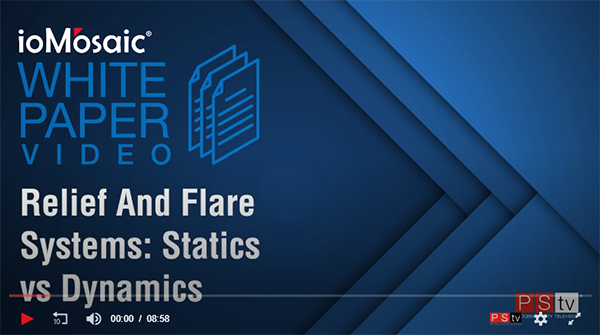RAGAGEP Considerations for Overtemperature Protection in Relief Systems
How to Calculate ETTF or ETTY in Fire Exposure Scenarios
Reasonable estimates of the expected time to failure (ettf) or expected time to yield (etty) are required and necessary for effective risk management as well as effective emergency and fire protection and response. Read this paper for a demonstration of calculating ettf or etty in fire exposure scenarios with Process Safety Office® SuperChems®.
Read the White Paper
Relief and Flare Systems Statics vs. Dynamics
The landscape of relief systems and general process safety management compliance is evolving. This evolution is due in part to enforcement or potential enforcement of recognized and generally accepted good engineering practices (RAGAGEP).
Because of RAGAGEP considerations, oversizing a relief device is no longer acceptable or desirable from an engineering perspective and from a legal liability perspective. For example, recent citations and enforcement by OSHA have considered the lack of toxic/flammable dispersion analysis and the lack of thermal radiation analysis for releases going directly to atmosphere. Other considerations include explosion risk, relief piping vibration risk, runaway chemical reactions, PRV stability, embrittlement due to cold temperatures, metal failure due to overheating 1, multiphase flow, etc.
The evaluation and/or design of emergency relief, vent containment, and flare systems require deep expertise and specialization. Many facilities place their trust in their engineering contractors to possess that deep level of expertise and to provide them with safe and compliant designs and evaluations. This paper contains case studies of why dynamics are needed in relief system evaluations for the most effective risk reduction from an overall or a lifecycle perspective.
View Our Videos
Please sign up for FREE or log in to Process Safety tv® to watch all the White Paper Videos.

Our Team
Georges A. Melhem, Ph.D., FAIChE
President & CEO
The founder of ioMosaic and internationally renowned expert in the areas of pressure relief and flare systems design, chemical reaction systems, process safety and risk analysis.
Read more...
Neil Prophet
Senior Vice President and Partner
He brings over 20 years of experience in pressure relief and flare systems design project management and engineering expertise for chemical, pharmaceutical and petrochemical companies.
Read more...
John Barker, Ph.D.
Director
The head of our international offices in the U.K. and the Kingdom of Bahrain and an expert in risk management for oil, gas and transportation.
Read more...
Marcel Amorós Martí
Director and Partner
His expertise consists of a diverse range of industries from chemical and petrochemical to oil and gas and utilities.
Read more...
Matthew LeVere, P.E.
Senior Safety and Risk Management Consultant
Experienced in PRFS design and analysis for clients in the petrochemical, chemical, and pharmaceutical industries.
Read more...
Neal Dahlheimer, CPPM
Senior Safety and Risk Management Consultant
Technical lead on PRFS projects for chemical, petrochemical and oil facilities as well as QA/QC reviews and training on advanced techniques for complex systems.
Read more...
James Close, CEng, MIChemE
Senior Consultant
Focused on pressure relief and flare system design and analysis for large chemical and petrochemical companies in Europe and the U.S.
Read more...
Christian Sarno
Senior Safety and Risk Management Consultant
Focuses on quantitative risk assessment (QRA), facility siting, pressure relief and flare system (PRFS) design and analysis for chemical and utility companies.
Read more...
Hamed M.H. Al Nahawi
Senior Consultant
Chemical engineer focused on pressure relief and flare system design and analysis for large chemical and petrochemical companies.
Read more...
Enio Kumpinsky, Ph.D.
Principal Consultant
Senior authority with over 35 years of diversified experience in process safety in the chemical manufacturing industry.
Read more...
Peter Stickles, P.E.
Principal Consultant
Senior authority with over 50 years of experience in chemical process safety, petroleum refining and petrochemical technology, and process design.
Read more...
Lin Ding
Safety and Risk Management Consultant
Focused on pressure relief and flare system design and analysis for large chemical, petrochemical, and utility companies in the United States and China.
Read more...
Jay Lin, P.E.
Senior Safety and Risk Management Consultant
Experienced in performing PRFS evaluation and design projects for clients in the chemical and petrochemical industries.
Read more...
Anna Shinkawa
Senior Safety and Risk Management Consultant
Over 12 years of experience managing and executing PRFS design, risk analysis, and PSM audits for chemical and petrochemical companies in the U.S.
Read more...
Ram Goyal
Consultant
A seasoned leader in engineering project management and safety standards, specializing in Quantitative Risk Assessment (QRA).
Read more...
Adam Baker, P.E.
Senior Consultant
He has over 10 years of experience performing quantitative risk assessments, facility siting studies, and providing process safety and relief system design support for clients across the globe.
Read more...
Daniel Wilkes, MIChemE
Safety and Risk Management Analyst
Experienced in pressure relief and flare system design and analysis for large chemical and petrochemical companies in Europe, the United States and the Middle East.
Read more...
Will Lomax, MEng CEng MIChemE
Over 5 years of experience focused on pressure relief and flare system design and analysis for large chemical and petrochemical companies in Europe, the Middle East, and the U.S.
Read more...